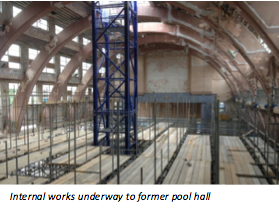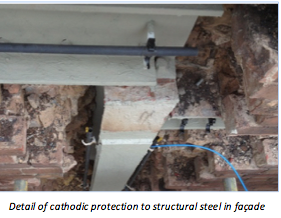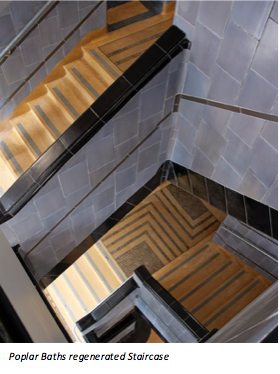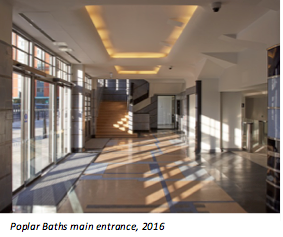Historic Information
 The Public Baths and Wash Houses Act of 1846-7 were passed as a result of public and religious pressure from figures like the Bishop of London. The Act gave all borough authorities the right to build public baths and was adopted by three metropolitan boroughs in London. By 1852, almost 200,000 people were regularly using nine newly built baths in London, including Poplar Baths on East India Dock Road.
The Public Baths and Wash Houses Act of 1846-7 were passed as a result of public and religious pressure from figures like the Bishop of London. The Act gave all borough authorities the right to build public baths and was adopted by three metropolitan boroughs in London. By 1852, almost 200,000 people were regularly using nine newly built baths in London, including Poplar Baths on East India Dock Road.
Poplar Baths represents an important part of Poplar’s history and the development of public health facilities in London in the interwar years. Architecturally the monumental façade of the First Class is an interesting example of modern civic design.
More than anything else, however, it is the reinforced concrete
arched  roof over the First Class pool which sets Poplar Baths apart from other municipal baths of the time. The use of this striking design by the local borough engineer’s department to create an impressive space for a municipal baths and community hall was imaginative, particularly given the borough council’s desire to use local labour. The plan form and layout followed the latest principles public hygiene, complemented by the grandiose Art Deco First Class entrance foyer.
roof over the First Class pool which sets Poplar Baths apart from other municipal baths of the time. The use of this striking design by the local borough engineer’s department to create an impressive space for a municipal baths and community hall was imaginative, particularly given the borough council’s desire to use local labour. The plan form and layout followed the latest principles public hygiene, complemented by the grandiose Art Deco First Class entrance foyer.
The original building included two pools, the larger of which would be covered over in the winter and used as a dance hall and cinema and for boxing and wrestling competitions. When covered, the hall could seat 1,400 people. The smaller pool remained open for swimming throughout the winter and as previously, hygiene facilities in the forum of individual “slipper baths” were provided. It is interesting that the local authority saw the equal importance of physical and cultural activity in improving the wellbeing of local people.
 The building remained under the local authority ownership, and in areas had been renovated according to contemporary standards before its closure in 1986. This included the loss of original features, most notably the slipper baths. After closure the baths were filled in concrete and the building crudely altered in a crude fashion for use by the London Dockland Development Corporation as a construction training centre.
The building remained under the local authority ownership, and in areas had been renovated according to contemporary standards before its closure in 1986. This included the loss of original features, most notably the slipper baths. After closure the baths were filled in concrete and the building crudely altered in a crude fashion for use by the London Dockland Development Corporation as a construction training centre.
It had stood derelict since 1994 and the fabric had materially deteriorated since, as well as having suffered break-ins. The building also suffered serious structural defects. In 2001 pressure from local residents to save the pool prevented its demolition and contributed to its listing, at Grade II. The Poplar Baths Steering Group was formed with the ambition of regenerating the building and reinstating the pool, however it would take another 16 years for their dream to become reality.
Design and Technical Information
- Guildmore managed the design process and achievement of planning permission
 and listed building consent for a scheme which protected the significant elements of building while permitting demolition of secondary elements to improve project viability and facilitate new leisure uses.
and listed building consent for a scheme which protected the significant elements of building while permitting demolition of secondary elements to improve project viability and facilitate new leisure uses.
- Retaining a single volume space to make the most of the visually and technically stunning original vaulted concrete arch construction.
- Removing the building’s history of class segregation and opening up the spaces to create a simple, legible, rationalised and unified amenity.
- Maintaining and using the beautiful things of the building: entrance, staircase, sports hall, including replacing the glazed clerestory and stepped windows.
- Major remedial works to concealed defective structure including cathodic protection to structural steel frame and removal of chlorine contaminated concrete.
- Conservation of historic building fabric including repairs to ceramic tiling and terrazzo finishes internally, brickwork and dressed stone externally, together with installation of over 170 replacement Crittal windows.
- Careful removal and recording of significant historic elements for later reinstatement including rare plunge pool.
- Selective demolition of part of existing buildings having regard to structural principles of the unusual catenary arch structure.
- Piling and basement excavation alongside live DLR tracks including contamination remediation.
- Management of logistics and deliveries for two parallel projects on an exceptionally tight site within a residential area.
- Simultaneous delivery on the same site of a 10-storey residential block containing 60 apartments.
- Wider regeneration project also includes 4-storey residential block containing 40 apartments, and a new community and youth centre containing sports hall, gym and rooftop playing pitch, on a nearby site in a conservation area.
- Financial model for a 35 year Public Private Partnership maintenance and operation contract.
Gross floor area
5251m2 GIA
Total area of site – hectares
2060m2 – 0.21ha
About the team
Main Contractor – Guildmore Ltd
Design-led and family owned Guildmore is a reliable provider of high quality, properties, where people, communities and business can flourish. Guildmore’s project portfolio includes private and public partnership schemes, sensitive historic renovations, leisure facility fit-outs and major refurbishment programmes.
Client – London Borough of Tower Hamlets
Situated north of the river Thames and east of the City of London, Tower Hamlets is a bustling and vibrant London Borough.
Leisure Operator – Greenwich Leisure Limited
Established in 1993, GLL is the largest UK-based not-for-profit charitable social enterprise delivering leisure, health and community services. Under the consumer facing brand Better, the organisation operates more than 200 public sport and leisure centres and 57 libraries in partnership with more than 30 local councils, public agencies and sporting organisations. Better leisure facilities enjoy 40 million visitors a year and have more than 650,000 members.
Architects – Pringle Richard Sharratt
Established in 1996, Pringle Richards Sharratt is known for its significant portfolio of cultural projects, including the award winning William Morris Gallery in Walthamstow and the Black Cultural Archives in Brixton; as well as its track record in urban landscape renewal and regeneration, most recently in Hull and Folkestone.
Structural Designers – PEP Civil and Structures Ltd
PEP are a Civil and Structural Engineering Consultancy, formed from the merger of two well established consultancies in the early 1990s. PEP currently work in the leisure, retail, commercial, industrial, residential, educational and healthcare market sectors, with project values ranging from £2 million to £250 million.
M&E – Peter Deer and Associates
Peter Deer & Associates Limited is an established award winning company with an exceptional portfolio of completed projects. The company was formed in 1995 by Peter Deer & Michael Humphries, who have created a platform where quality engineering can be applied across the field of construction.



